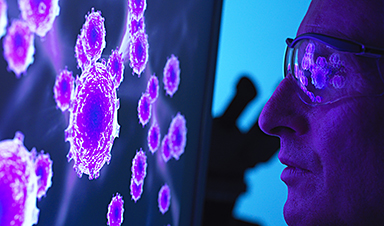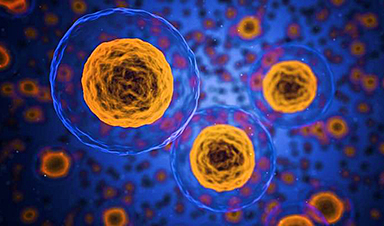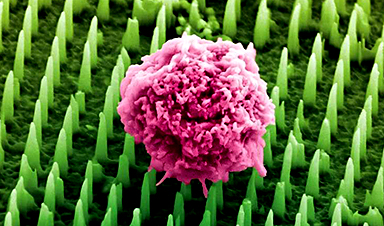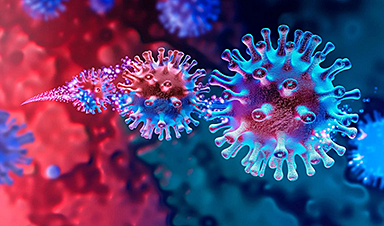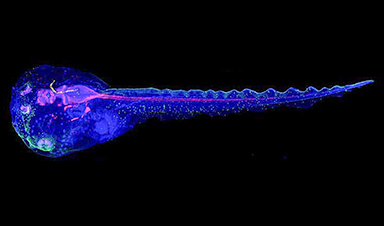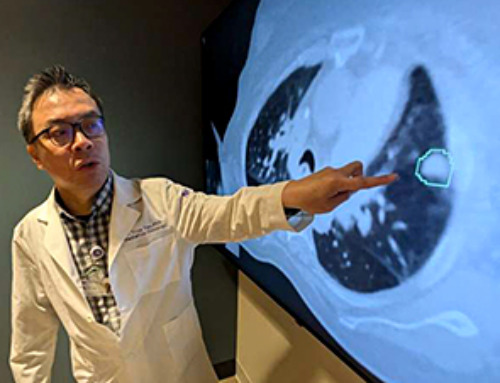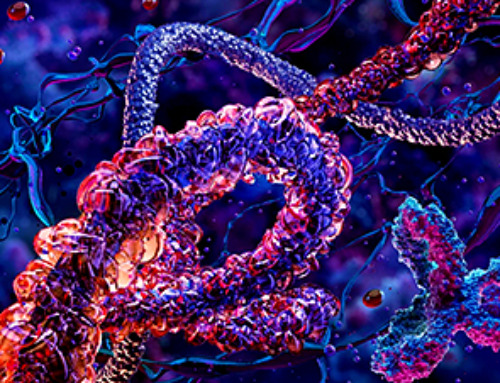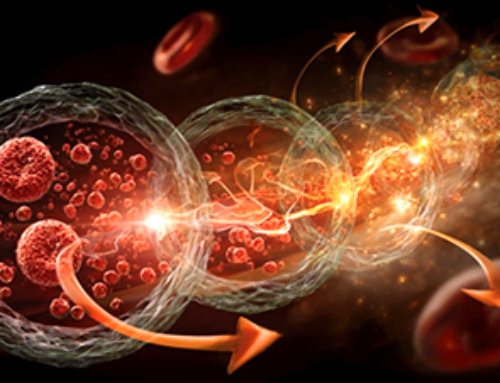When Jedi Knights need to vanquish an enemy, they whip out their trusty lightsabers. In the future, thanks to Johns Hopkins researchers, doctors seeking to crush cancer may wield minuscule molecular nanoSABERs that allow them to look at tumors in ways never before possible.
“This could be a game changer for cancer treatment,” said Barman, an associate professor of mechanical engineering at the Whiting School, of the self-assembling biorthogonal enzyme recognition (nanoSABER) probes. The team’s results appear in Advanced Science.
Currently, tissue biopsies are the gold standard for detecting most cancers, though they can be inexact and even miss parts of tumors lurking in the margins. The Johns Hopkins team’s approach could solve that problem, allowing clinicians to visualize cancerous activity across entire tumors, providing insights into their possible aggressiveness.
Enzymes, especially legumain, play a leading role in the development and progression of cancer.
The team’s new tool assembles itself in the presence of these cancer-related enzymes and emits a signal that can then be picked up by Raman spectroscopy, a visualization technique that analyzes molecular vibrations to identify and characterize substances. This allows the probes to pinpoint cancer cells accurately.
The Johns Hopkins team says its method also could allow clinicians to more accurately monitor the accumulation of cancer drugs in tumors during treatment, providing an indication of how well those treatments are working.
“The probes’ ability to offer a clear look at the molecular, cellular, and tissue levels provides a comprehensive perspective,” said lead author Swati Tanwar, a post-doctoral fellow in mechanical engineering. “It is imperative to understand what is really happening at the tumor margins to ensure complete cancer removal and minimize the chances of recurrence.”
Study co-authors at Johns Hopkins include Behnaz Ghaemi, Piyush Raj, Aruna Singh, Lintong Wu, Dian R. Arifin, and Michael T. McMahon. The team also included Yue Yuan of the University of Science and Technology of China.
More information: Swati Tanwar et al, A Smart Intracellular Self‐Assembling Bioorthogonal Raman Active Nanoprobe for Targeted Tumor Imaging, Advanced Science (2023). DOI: 10.1002/advs.202304164
Journal information: Advanced Science
News
AI matches doctors in mapping lung tumors for radiation therapy
In radiation therapy, precision can save lives. Oncologists must carefully map the size and location of a tumor before delivering high-dose radiation to destroy cancer cells while sparing healthy tissue. But this process, called [...]
Scientists Finally “See” Key Protein That Controls Inflammation
Researchers used advanced microscopy to uncover important protein structures. For the first time, two important protein structures in the human body are being visualized, thanks in part to cutting-edge technology at the University of [...]
AI tool detects 9 types of dementia from a single brain scan
Mayo Clinic researchers have developed a new artificial intelligence (AI) tool that helps clinicians identify brain activity patterns linked to nine types of dementia, including Alzheimer's disease, using a single, widely available scan—a transformative [...]
Is plastic packaging putting more than just food on your plate?
New research reveals that common food packaging and utensils can shed microscopic plastics into our food, prompting urgent calls for stricter testing and updated regulations to protect public health. Beyond microplastics: The analysis intentionally [...]
Aging Spreads Through the Bloodstream
Summary: New research reveals that aging isn’t just a local cellular process—it can spread throughout the body via the bloodstream. A redox-sensitive protein called ReHMGB1, secreted by senescent cells, was found to trigger aging features [...]
AI and nanomedicine find rare biomarkers for prostrate cancer and atherosclerosis
Imagine a stadium packed with 75,000 fans, all wearing green and white jerseys—except one person in a solid green shirt. Finding that person would be tough. That's how hard it is for scientists to [...]
Are Pesticides Breeding the Next Pandemic? Experts Warn of Fungal Superbugs
Fungicides used in agriculture have been linked to an increase in resistance to antifungal drugs in both humans and animals. Fungal infections are on the rise, and two UC Davis infectious disease experts, Dr. George Thompson [...]
Scientists Crack the 500-Million-Year-Old Code That Controls Your Immune System
A collaborative team from Penn Medicine and Penn Engineering has uncovered the mathematical principles behind a 500-million-year-old protein network that determines whether foreign materials are recognized as friend or foe. How does your body [...]
Team discovers how tiny parts of cells stay organized, new insights for blocking cancer growth
A team of international researchers led by scientists at City of Hope provides the most thorough account yet of an elusive target for cancer treatment. Published in Science Advances, the study suggests a complex signaling [...]
Nanomaterials in Ophthalmology: A Review
Eye diseases are becoming more common. In 2020, over 250 million people had mild vision problems, and 295 million experienced moderate to severe ocular conditions. In response, researchers are turning to nanotechnology and nanomaterials—tools that are transforming [...]
Natural Plant Extract Removes up to 90% of Microplastics From Water
Researchers found that natural polymers derived from okra and fenugreek are highly effective at removing microplastics from water. The same sticky substances that make okra slimy and give fenugreek its gel-like texture could help [...]
Instant coffee may damage your eyes, genetic study finds
A new genetic study shows that just one extra cup of instant coffee a day could significantly increase your risk of developing dry AMD, shedding fresh light on how our daily beverage choices may [...]
Nanoneedle patch offers painless alternative to traditional cancer biopsies
A patch containing tens of millions of microscopic nanoneedles could soon replace traditional biopsies, scientists have found. The patch offers a painless and less invasive alternative for millions of patients worldwide who undergo biopsies [...]
Small antibodies provide broad protection against SARS coronaviruses
Scientists have discovered a unique class of small antibodies that are strongly protective against a wide range of SARS coronaviruses, including SARS-CoV-1 and numerous early and recent SARS-CoV-2 variants. The unique antibodies target an [...]
Controlling This One Molecule Could Halt Alzheimer’s in Its Tracks
New research identifies the immune molecule STING as a driver of brain damage in Alzheimer’s. A new approach to Alzheimer’s disease has led to an exciting discovery that could help stop the devastating cognitive decline [...]
Cyborg tadpoles are helping us learn how brain development starts
How does our brain, which is capable of generating complex thoughts, actions and even self-reflection, grow out of essentially nothing? An experiment in tadpoles, in which an electronic implant was incorporated into a precursor [...]








